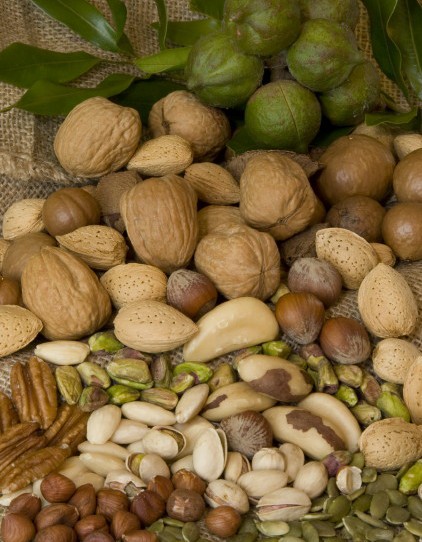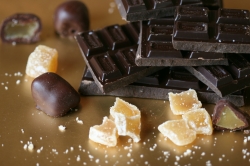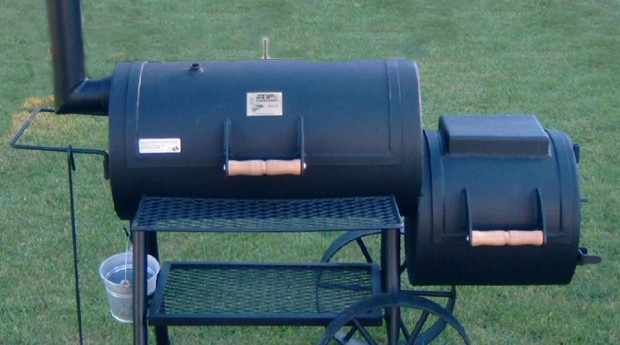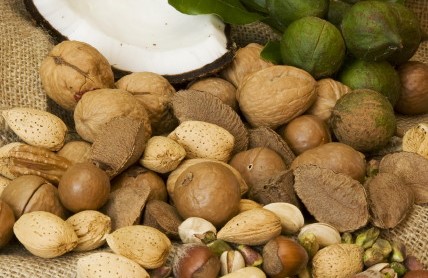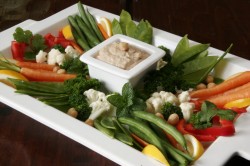Pomegranates: Long Loved, Newly Cherished
Phytochemicals of Pomegranates and Their Health Benefits
Nutritional Facts of Pomegranates
Shopping Tips
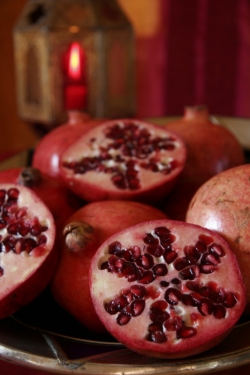
Pomegranates are one of the oldest fruits known to humans. Thousands of years ago, ancient civilizations used the fruit and other parts of the plant for nutritional and medical purposes. They have been—and remain—a symbol of life, hope, fertility, prosperity and health.
After settlers introduced pomegranates to the U.S. in the late 18th century, California established itself as one of the main growing regions in the country. Yet it wasn’t until a few years ago that pomegranates received wide attention. Rather suddenly, research on them multiplied, and pomegranates became increasingly well known for their richness in antioxidants as well as their manifold health benefits. Today, a large variety of products, including the fruit itself, juices, oils, syrups (grenadine) and wines, are regularly available in grocery stores.
Fun Fact: The word “pomegranate” means “apples with many seeds.” Each fruit contains about 840 seeds.
Phytochemicals of Pomegranate and their Health Benefits
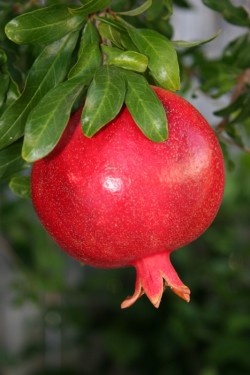
The health benefits of pomegranates are widespread. Studies have found that they not only may be beneficial in fighting a number of cancers, including prostate, breast, lung, colon, skin and liver, but may also improve cardiovascular health as well as erectile dysfunctions. In addition, studies have reported anti-inflammatory properties, and pomegranate oil has been found to exhibit weak estrogen-like actions that may benefit menopausal women. Furthermore, pomegranates possess antimicrobial and antiviral compounds. This could make them useful for the food industry as a natural preservative in foods.
The major active compounds in pomegranates are antioxidative polyphenols. Similar to berries, the pomegranate arils obtain their red color from polyphenolic anthocyanins. (For more information, see our article “Berries: Vibrant Flavors Bursting with Nutrition.“)
However, the majority of the antioxidative activities is carried out by so-called hydrolyzable tannins, which are polyphenols as well(1). In particular, one tannin, punicalgin, is said to be responsible for more than 50% of the antioxidative strength alone(2).
One of the most extensively researched aspects of pomegranates is their effect on prostate cancer. This type of cancer is, according to the American Cancer Society, the second most common cancer among men and, therefore, of great interest to researchers. Pomegranate extracts and pomegranate juice have been found to be potentially beneficial in treating prostate cancer. Researchers have been able to demonstrate that they may stop prostate cancer cell growth, induce cancer cell death and inhibit angiogenesis (growth of new blood vessels that supply tumors with nutrients and oxygen). Also, tests(2) have shown that PSA (prostate specific antigen, an indicator of inflammation or cancer of the prostate) levels may be lowered by pomegranates. In addition, further studies indicate that pomegranates might not only help treat but may also help prevent prostate cancer(3).
Another interesting aspect of pomegranates is their effect on the cardiovascular system(4,5). Studies have revealed that pomegranate juice may lower blood pressure and improve blood flow. Also, low density lipoprotein (LDL) oxidation and macrophage foam cell development may be reduced. Both processes are seen as a precursor for atherosclerosis. Therefore, pomegranates may be considered heart-protective.
Nutritional Facts of Pomegranate
In addition to health benefits derived from the phytochemicals, pomegranates contribute significantly to the daily vitamin C as well as potassium needs. In the nutritional facts(6) table below, the values are given for a regular sized fruit.
| Raw Pomegranate | |
| Calories | 105 kcal |
| Carbohydrates | 26 g |
| Dietary Fiber | 1 g |
| Protein | 1 g |
| Fat | 0 g |
| Water | 125 g |
| Main Vitamins | C, K, Pantothenic Acid & B 6 |
| Main Minerals | Potassium & Copper |
Shopping Tips
Pomegranates grown in the U.S. are in season during the fall and winter months. During the remaining part of the year, pomegranates available at the produce section of your grocery store are more likely to be imported.
The edible parts of the fruit, the arils, have a sour to sweet taste depending on the grade of ripening. The surrounding white tissue is rather bitter.
Pomegranates are harvested ripe, so they should be ready to eat at the time of purchase. Nevertheless, always pick the ones that are heavy for their size. The heavier they are, the more juice they contain. It’s also important that the fruit skin has no cracks or bruises.
The fruits will stay fresh for a few days in a dark place at room temperature. To last longer, they should be refrigerated.
Pomegranates can be enjoyed simply by themselves or added to other dishes, such as salads. However, it can be quite time-consuming and tricky to get all arils out of a pomegranate to eat. Hence, juice might be a tasty and more convenient alternative for you. Besides, pomegranate juice has been shown to have higher antioxidative strength than red wine, Concord grape juice, blueberry juice or black cherry juice(7). This makes pomegranates currently one of the fruits with the highest known antioxidant content.
Pomegranate juice can be made at home. For that purpose, dispersing the arils in a blender or using a hand-press juicer are good methods. After juicing, the seeds can be removed by straining the juice, if desired.
A more convenient, but perhaps also more expensive alternative is store-bought pomegranate juice. If that is an option for you, it’s best to choose whole-fruit pomegranate juices. They can have up to 20 times more antioxidative strength compared to juice made only from the arils. Also, taking the time to read the ingredients label, especially in mixes of several fruit juices, is very important. This way undesirable additives, such as sugar or high fructose corn syrup, can be avoided.
Exotic fruits like pomegranates may have much to offer for our health, and seem to be a great part to a nutritious diet. Indeed, many people refer to them as “superfruits.” The U.S. National Institutes of Health is listing nine in-progress clinical trials to extend existing knowledge and reveal further, perhaps even more exciting effects of pomegranates on our health.
References
(1) Malik A, Afag F, Sarfaraz S, Adhami VM, Syed DN and Mukhtar H:Pomegranate fruit juice for chemoprevention and chemotherapy of prostate cancer. Proceedings of the National Academy of Sciences of the United States of America 2005;102(41)14813-14818.
(2) Pantuck AJ, Leppert JT, Zomorodian N, Aronson W, Hong J, Barnard RJ, Seeram N, Liker H, Wang H, Elashoff R, Heber D, Aviram M, Ignarro L and Belldegrun A: Phase II Study of Pomegranate Juice for Men with Rising Prostate-Specific Antigen following Surgery or Radiation for Prostate Cancer. Clinical Cancer Research 2006;12(13)4018-4026.
(3) Seeram NP, Aronson WJ, Zhang Y, Henning SM, Moro A, Lee R, Sartippour M, Harris DM, Rettig M, Suchard MA, Pantuck AJ, Belldegrun A and Heber D:Pomegranate Ellagitannin-Derived Metabolites Inhibit Prostate Cancer Growth and Localize to the Mouse Prostate Gland. Journal of Agricultural and Food Chemistry 2007;55:7732-7737.
(4) Aviram M, Rosenblat M, Gaitini D, Nitecki S, Hoffman A, Dornfeld L, Volkova N, Presser D, Attias J, Liker H and Hayek T: Pomegranate juice consumption for 3 years by patients with carotid intima-media thickness, blood pressure and LDL oxidation. Clinical Nutrition 2004;23:423-433.
(5) Aviram M, Dornfeld L, Rosenblat M, Volkova N, Kaplan M, Coleman R, Hayek T, Presser D and Fuhrman B: Pomegranate juice consumption reduces oxidative stress, atherogenic modifactions to LDL, and platelet aggregation: studies in humans and in atherosclerotic apolipoprotein E-deficient mice. The American Journal of Clinical Nutrition 2000;71(5)1062-1076.
(6) NutritionData – Nutrition Facts and Calorie Counter: Pomegranate.www.nutritiondata.com, retrieved February 2008.
(7) Seeram NP, Aviram M, Zhang Y, Henning SM, Feng L, Dreher M and Heber D: Comparison of Antioxidant Potency of Commonly Consumed Polyphenol-Rich Beverages in the United States. Journal of Agricultural and Food Chemistry 2008;56(4)1415-1422.
- Posted March 27, 2008
© Copyright 2008-2024 by Take The Magic Step®. All Rights Reserved.
